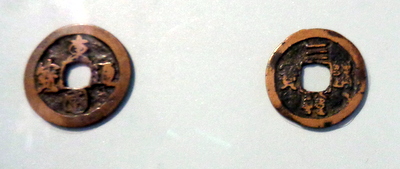
The earliest Korean coins were minted and circulated for about one hundred years, from about the 990s to around 1105. Based on Tang Dynasty Chinese currency, the coins were imprinted with terms including Haedong ("East Sea"), Samhan ("Three Kingdoms"), and Dongguk ("Eastern Kingdom").
Such coins have mainly been found in excavations at Kaesong, the capital of Goryeo, and do not seem to have circulated widely to/in other parts of the peninsula.
In the early modern period, from 1678 until the late 19th century, some fifty different agencies across Korea produced coins called sangpyeong tongbo (常平通宝). These "stabilization coins" were named after the Joseon court's efforts at stabilizing the economy through limiting taxes, from payments in kind (grain and various other products), to more strictly having to be paid either in coin, cotton, or rice.
Modern Korean currency might be said to have gotten its start in 1882, with the introduction of the Daedong eunjeon, or "silver coin of the Great East," which filled in the square hole traditionally found at the center of East Asian coins. Due to dramatic changes in the price of silver, these coins were taken out of circulation the following year. The year after that, in 1884, Seoul's central mint began mass-producing coins by machine for the first time, in silver and bronze.
Today, the Korean currency is known as the won. Exchange rates fluctuate, but very roughly tend to stand around 10 won to the yen, or 1000 won to the US dollar.